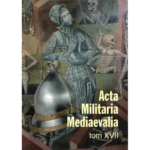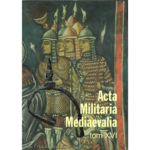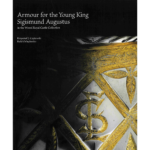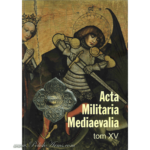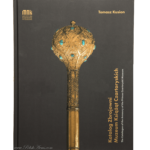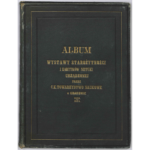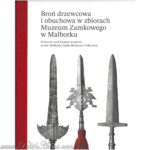
Two incrusted medieval swords from Zbaszyn
| ARTICLE | |
 |
Marian Glosek & Tadeusz Makiewicz
“Two incrusted medieval swords from Zbaszyn“
|
Originally printed in Gladius, Tomos XXVII (2007); http://gladius.revistas.csic.es/index.php/gladius
In the area of Zbaszyn, in Lake Zbaszynskie, two interesting medieval swords were accidentally found. They are both incrusted but they significantly differ in ideological programme. The size of sword 1 (fig. 1)is : general length 75.8 cm preserved, length of the blade 59 cm (preserved), 5.3 cm wide at the forte, length of the hilt – 15.8, height of the guard 1 cm, length of the guard 19.7 cm, height of the pommel – 4.5 cm, width of the pommel – 7.1 cm, thickness of the pommel in its upper part 2.0 cm; thickness of the pommel in its lower part 2.6 cm; thickness of the tang 0.6 cm.
The size of sword 2 (fig. 2) is: general length 108.7 cm, length of the blade 90.7 cm; width of the pommel at the top 6.0 cm; length of the hilt 17 cm; maximum width of the tang 3.3 cm; height of the guard 1.0 cm; length of the guard 17.5 cm; diameter of the pommel 5.0 cm; maximum thickness of the pommel 3.2 cm. Sword number 1 is incomplete, badly preserved. The point of the sword is broken; the edge of the pommel is strongly jagged. The sword on one face of the pommel, in the fuller has an inscription, on the other – an ornament. Both the inscription and the ornament were made by filling in of non-ferrous metal into previously made grooves. The inscription was made with silver and the ornament with yellow metal (copper?). The non-ferrous metal both in the inscription and in the ornament has not wholly preserved. In some cases, only the groove remained and it renders the shape of a letter or ornament. The grooves as well as their fillings of non-ferrous metals in the inscription are broader then the grooves and the yellow metal in the ornament.
The broken blade of the sword impedes a typological analysis of the artifact. It is a onehanded sword with a long and relatively wide fuller; it has its closest analogies in type XII in R. E. Oakeshoott`s classification [1].The swords are dated to the 12th and 13th centuries. Guards bended towards to the blade were most popular in the 13th and 14th centuries. In the literature, I could not find analogies to a pommel, which appeared in case of a sword from Lake Zbaszynskie. Its untypical shape causes that it may be earliest dated to the 13th century.
Sword number 2 is a complete one. After incrustation, a negative remained and only in not numerous fragments white metal remained (silver?). On both faces of the blade, just under the forte in the fuller there is a lion standing on its hind legs with a single scut and a vegetalgeometric ornament on the coats of arms. Lower, at the beginning of the point, there is a slightly visible another fragment of the ornament.
This is a one-handed sword, with blade slightly widened at the forte and regularly narrowing towards the rounded point. The fuller begins on the tang and reaches up to 3/4 of the blade. The shape of the sword is the reason why it should be included among type XII according too R. E Oakeshott. The pommel is of type H and the guard of type 1 of this classification [2] and in classification of A. Bruhn Hoffmeyer [3], it is a hilt of type IIIb. These are swords that appeared from the 2nd half of the 12th century to the beginning of the 14th century. They were most popular in the 13th century.
From these descriptions it appears that, despite the differences in pommels shape, the swords are typologically similar and chronologically contemporaneous. They are also connected by a place of their discovery. They definitely differ in ornamental programme represented on them.
Preserved cross-shaped signs, made before, and behind an inscription on sword 1 indicate that the inscription is complete. The cross-shaped signs are made in the same technique as the inscription, also their size corresponds with the shape of the letters. Similarly, ornament on the other side of the blade is completely preserved what is testified by limitations by an ornament of other type, which appear at the beginning and remnants at the end of cyclically repeated decoration. What also attracts attention is that the length of repeating ornament is almost equal with the inscription on the reverse of the blade. However, not all the letters are wholly preserved and therefore there may be doubts about their proper reading. In our opinion, the inscription is made in Roman majuscule and consists of the following letters: +Sc.S.BENEDIC.T(?)US: R(?)IXOEIMR(P?)AUL(?)V(U).S:E+ (fig. 1). What is important is that letters U, which were three times read, each time have various shapes. This letter, which appears for the third time is clearly V-shaped; also in other inscriptions on swords it is written in a shape resembling two first letters on our artifact, as for instance on a sword from the Museum für Geschichte der Stadt Leipzig [4] or it is V-shaped as on a sword found in Paczkow [5]. However, it is not a rule because on the same sword from Paczkow as well as in whole inscriptions on other swords, the letter V appears as V. Inscription from Lake Zbaszynskie should be included into a group of inscriptions with word BENEDICTUS continuation of which is, in our opinion, an initial inscription [6]. In total, I know 12 swords with inscriptions
in which this word appears [7]. However, not always continuation of the inscription is an initial inscription. In some cases, they are complete words.
The earliest inscription of this type – appears on a guard of a sword from Buxtehude (Hedendorf) near Hanover. The sword is of type D according to J. Petersen`s classification [8] and is dated to VIII-IX centuries; the inscription is – on one side of the guard BENEDICT…, and on the other – IFDNSDSN [9]. In the bottom part of the pommel an inscription also appears but its poor state of preservation makes it impossible to read it. Another sword with an inscription of this type comes from the 11th century and was found in Elvran near Trondheim. The inscription on the sword was also made on its guard – on one side BENEDICTUD DN and on the other ?SGS…SQUIDO [10]. Other swords in the literature are in general unanimously dated to the end of the 12th and beginning of the 13th or to the 13th centuries. In one case only, on a coronation sword of the emperor Otto IV, with a hilt dated to the years 1208-1215 [11], the inscription is placed on the guard and pommel whereas on the rest of the swords – on the blade.
Sword found in Paczkow (Poland) is of crucial importance for our consideration on inscriptions of the Benedictus group. On one face of the blade of this sword there is an inscription +BENE[DI]CTUS[DOM]INUS DEVSMEVS…VID…, whereas on the other ADPRELIOSETDIGITOSMEOS… . As M. Glosek and L. Kajzer stated [12], it is a fragment of psalm CXLIII verse 1, and its full text is as follows: BENEDICTUE DOMINUS DEUS MEUS, QUI DOCET MANUS MEAS AD PRELIUM ET DIGITOS MEAS AD BELLUM [13].
Owing to extensive fragment on the sword from Paczkow, it can be stated that the beginning of this verse also appears on the pommel of the coronation sword of emperor Otto IV (1198-1215). The inscription is BENEDICTUS DOS DES MEVS QUI DOCET MANUS [14]. On the guard of the sword, there is another inscription: CHRISTUS VINCIT CHRISTUS REIGNAT CHRIST. INPERAT. The beginning of psalm CXLIII verse 1 can be also visible
on the pommel of a sword stored in the Historical Museum of Leipzig (Museum für Geschichte der Stadt Leipzig, Altes Rathaus) [15]. The inscription on this sword is BENEDICTUS DEUS MEUS. Inscriptions in form BENEDICTUS DEVS, which may also be a short form of a verse of this psalm appear on coins from the end of the 14th century and were minted by the Association of Hanseatic Towns and also Pomeranian towns such as Anklam, Wolgast,
Szczecin or Stargard.
On the sword from Lake Zbaszynskie, we can only read one word BENEDICTUS that in a way connects this sword with psalm CXLIII verse 1. It cannot be definitely stated that it is a fragment of this psalm. Not only this psalm begins with the word BENEDICTUS and they appear on artifacts not only in the Middle Ages. On framing legend of gros tournois, minted since 1266 in France there is an inscription BENEDICTUM SIT NOME DNI NRI DEI IHV XPI, which is not such an exact reflection of the psalm, in this case CXII verse 2, which is Sit nomen Domini Benectum ex hoc, nunc, et usque in saeculum, but is connected with this psalm [16]. Another text that begins with the word Benedictus, which refers to psalm 117 verse 26 is an expression BENEDICTUM QVI VENIT IN NOMINE DOMINI that apperared in the 2nd half of the 14th century on grosz coins, so-called “pot” ones in the Netherlands.
Five swords are known with the Benedictus word which is accompanied, as continuation, by an initial inscription or incorrectly written words, often in incomplete form with the use of abbreviations, and on 2 other swords, likewise on our artifact, before the word Benedictus there are three letters which should also be treated as an initial inscription. A. N. Drboglav distinguishes inscriptions beginning with this word as a separate group of inscriptions
determing them as a group [17]. However, inscriptions are not always placed on one face of the blade, as it is on our sword. Sometimes continuation of the inscription is made on the other side. There are some doubts whether the continuation is an initial inscription or incorrectly words or abbreviations. It especially concerns inscriptions on a sword found in Levetzov near Wismar [18]. On this sword on one side of the blade there is an inscription +BENEDICATINIUSDICI.RA. ICNIUIOMUENIE…+, and on the other +NIUSUSDICNIUSDIC. RADIXNIEITRAION..NE… . In the inscription, apart from the word BENEDICAT, we can also discern incorrectly written words NIUSUS- NISUS, DIGNUS RADIX. M. Głosek and L. Kajzer are of opinion that the inscription on this sword is : BENEDICAT IN IUS D(omini) CH(rist)I RADIC(is) N(ostr)I V(iv)I OM(inis,-en,-nes) VENIE(-ntis,-ns, -ntes)… [19]. D. A. Drboglav interprets this inscription in a bit different way seeing a bigger number of initial letters: Benedic, A(ltissime) t(er), i(n), n(omine) I(esu) s(alvatoris), d(omoni) I(esu), C(hristi) I(esu), t(er) r(edemptoris) a(nimarum) [I(es)u] C(risti), N(omine) I(es)u, I(esu) o(mnipotentis), M(arie) v(irginis) e(terne). N(omine) Ie(su)… [20]. Inscription on the other side of the sword may be included into other group of initial inscriptions, so-called DIC group which in the literature is worked out as D(ominus) J(esus) C(hristus) [21]. The group of letters DIC in case of the sword from Levetzov is also accompanied by the word Benedictus. It is the only known by me case where this aggomeration appears. On analysing of the inscription on the sword from Lake Zbaszynskie also the inscription on a sword found in Liuksiala (Kangsala – Finland) [22] should be considered. M. Głosek i L. Kajzer interpret that inscription on one side of the blade as: +BENEDICAT+N.ISDOCATRA AO.N….ELVMI…, whereas on the other as +N…IE…BEI.SMIE.DOC…A…CIUS.N+. Another lesson of the inscription is given by A. N. Drboglav: +BENEDIGATINTUSDOGATRA…, …PICIUS[N]n+ [23]. As it can be noticed, the inscription on the sword from Lake Zbaszynskie is considerably shorter than inscriptions on the swords from Levetzov and Liuksiala. However, in the inscription on our artifact agglomerations of at least 2 letters appear, which can also be seen in any of the inscriptions and also in both on the swords from Levetzov and Liuksala. For instance, letters EI, Us and RA appear next to each other in inscriptions on these three swords. Agglomeration of letters IX appears in the inscription on the sword from Levetzov, whereas letters LU, taking into account that letter U is written as V and inversely, appear in the inscription on the sword from Liuksala. Single letters R, O, M and U appear in the inscriptions on these three swords. Thus, all the letters in the inscription on the sword from Lake Zbaszynskie also appear on the swords from Levetzov and Luksiala. It can be thought that full reading and sense of the inscription on the sword from Lake Zbaszynskie is similar but not the same as on both other swords.
Connection of the inscriptions from Lake Zbaszynskie, Levetzov, and Liuksiala with psalms, despite the fact that the word Benedictus, which also appears in the inscription from psalm on the sword from Paczkow, suggests it, is not so obvious. We did not notice proper verse among the psalms, which would begin with letters that appear on our swords. We did not find proper fragment in the Allegory Book. However, it seems that this is the right way of searching for solution to this inscription through texts connected with liturgy and Christian rites, not necessarily with the Bible. It can not be completely excluded that it is an inscription full reading of which was only known by the sword`s owner.
Letters ScS which appear before the word Benedictus on the artifact from Lake Zbaszynskie have no analogies on other swords. It should be however stated that letter c is weakly visible on our artifact and it cannot be excluded that it is letter O. Agglomeration of letters SOS that appears at the beginning as well as at the end of the inscription is known from several swords found in Central Europe [24]. However, they are not inscriptions, which contain the word “Benedictus”. Sometimes at the beginning of the inscription there are letters SOS and at the end – OSO. At the same time, different sizes of the letters and their different cutting suggest that the letters do not have any close connection with inscription that appears before or after them. In not numerous cases, these letters appear on swords as a separate inscription on both sides of the blade. In collections in Poland the letters SOS as an initial shortening appeared in the middle of a developed text on the sides of facing of the coronation sword`s grip of the Polish kings, so-called “Szczerbiec” [25]. It is the only known by me example when these letters are placed in the middle of the inscription. Unfortunately, the inscription has not preserved and is only known from graphic documentation made in 1792 [26]. The inscription was “Cum quo ei Dominus S. O. S. (Salvator Omnipotens Salvator) auxilietur adversus partes amen”. The sword is analogous with swords of king Sancho Iv el Bravo and so-called Santa Casilda [27]. It was made for Boleslav Pobozny, duke of Great Poland and is dated to the years 1257-1279 [28].
In two cases in inscriptions on swords before the word Benedictus each time three letters appear. On a sword found in Fornham, England, dated to 1171, there are letters SES [29], whereas on a sword found on the island of Saarema (Estonia), dated by A. Anteins to the 13th century, and by D. A. Drboglav to the beginning of this century, these are letters SXS [30]. Considering that on the atrifact from Lake Zbaszynskie there appear letters ScS; this abbreviation can be read as “s(an)c(tu)S”. However, if we assume that a dot in the inscription on the sword after the letter “c” is separating the words, we can also develop the inscription as “S(an)c(tus) S(alvator)” or S(an)c(tus). S(anctus)”. The dots in the inscription are not always placed
according to a rhythm of the words and may even appear in the middle of the letter. Letters RIX after the word Benedictus can be developed as (R)ex (J)esus (X)ristus. In such a case, the beginning of the invocation would be “Sanctus. Benedictus Rex Jesus Christus…”. Such an expanding of the inscription causes that the fragment can not be quoted from the Old Testament so it can not be one of the psalms but it should be looked for in the New Testament or in texts connected with Christian rites.
As it appears from the above, the inscription on the sword from Lake Zbaszynskie belongs to the group of swords with the Benedictus inscription. Within the group, we can however distinguish inscriptions of full reading of the words and those, which before and after the word Benedictus are initial ones.
On the sword from Lake Zbaszynskie complete words – in different variants, although wrongly written, may be discerned. On reading the letters one after another from 21 to 26 we get the word PAULUS. It should be stressed that the reading of the letter P is doubtful as well as the arrangement of the letters may be accidental, the more so because after that possible name there individually appears letter E, which in this case should be treated as an initial one. At the same time, on assuming that after the word BENEDICTUS the letter R is wrongly read by us as or wrongly made by a craftsman and it is the letter F, we read the word FIOXOE (fixe, fixus). In such a case in this word there are as many as two mistakes, and addition of the letter O seems not very probable. The fourth and fifth letters from the end are weakly visible. After the word FIXOE the word IMPAVI(D)DUS can be discerned. In the inscription, however, clearly, there is not the letter D, as well as after the letter V a clear dot is visible, and it should be thought that there were three dots after the letter S. Similar dots are made after the word BENEDICTUS, undoubtedly as a sign separating two words. A designer or artisan who made the inscription was although inconsequent enough that he placed two dots also in the middle of the word as well as in the middle of the letters. Therefore, dashes that appeared in needless spaces may be results of a wish to embellish the sword by an artisan. On representing such a possibility of reading of the text on this sword, we however think that it is not very probable and, according to us, it is an initial inscription, in which each letter is the beginning of a word.
Swords with inscription Benedictus occur on considerable area but in substance they are only limited to north Europe. Our specimen from Paczkow and Lake Zbaszynskie is the southermost. Also chronological range of the occurence of swords with the Benedictus inscription and initial letters is quite considerable and is confined to the 9th – 13th centuries. The artifact from Lake Zbaszynskie because of its untypical pommel which foreran new forms of this part of sword as well as because of the chronology of analogous swords of this type we are inclined to date it to the 1st half of the 13th century. At the same time, a fact that inscriptions and ornaments appeared on swords, what lowered the cost of production, causes that they undoubtedly belonged to rich people, who came from a narrow elite of medieval knighthood.
On the other sword found in Lake Zbaszynskie (fig. 2), there is no inscription. The fact that a heraldic shield with a lion was placed on it indicates that it is heraldic arms. An important element that limits the scope of our consideration is a position of the lion (it is standing on its hind legs) and the fact that it only has one scut, because lion which scut forks at the half of its length is often represented in heraldry, and is qualified as lion with a double scut.
It is not the only sword with lion on the heraldic shield of close or the same chronology, found on Polish – German borderland. The closest specimen is an artifact found in Santok [31] but also a sword found in Odra near Szczecin [32] should be considered, or the one from an unknown town, stored in the Museum für Deutsche Geschichte in Berlin [33] which resembles the artifact from Santok in the way of arms placement.
Swords with arms of lion standing on its hind legs placed on the blade or pommel are found almost in the whole Europe. Arms of lion standing on its hind legs are very popular in Europe and were used by houses, towns, lands and also used as state arms. The situation does not make it easier to define the affiliation of the sword, especially in case when only one kind of arms appears and there are no heraldic colours. Our artifact from Lake Zbaszynskie has
arms of lion with a single scut but the half of the 13th century is a period of formation of arms, and in its initial phase a lion standing on its hind legs, and later a lion with a double scut were used, as it happens in case of the arms of the Chech king Przemysl Ottokar II.
At the attempt of defining the circle of people to be connected with the sword the Luxembourgs should be considered; they arms is lion standing on its hind legs with a single scut, although in this case , in this part of Europe they appear too late, towards the decline of dating of our sword. The lion with a single scut is also arms of the Habsburgs but also in this case it is difficult to detect the reasons of how the sword connected with this family got on the area of our interest. Also landgraves of Thuringia and Hessia used the arms of lion, and one of them, Konrad (1239-1241) was the Grand Master of the Teutonic Knights. Misnia and Lusatia, which were under the rules of the Vettines, whose arms was also lion standing on its hind legs with a single scut especially draw attention. The king of Chech, Przemysl Ottokar II also should be taken into consideration in the period when he was the margrave of Moravia (1247-1253) also used the arms of lion with a single scut. The sword found in nearby Santok, because of the arms and a march of knights shown on it is just connected with this sovereign [34].
Finds of numerous military accessories from the 12th – 14th centuries [35] found in Lake Zbaszynskie as well as in its outflow – the river Obra testify military conflicts that took place in the area, as well as indirectly military and political alliances. Henry III, the duke of Wroclaw (died 1266) allied with the margrave of Misnia and landgrave of Thuringia – Henry the Enlightened who in return for help in the fight against his brother, the duke of Silesia – Boleslav II (died 1278) promised the Land of Krosno or a strip of land between the Kwisa and Bobr rivers. Boleslav II, then, allied with archbishop of Magdeburg and gave him the half of the city and the Lubusz Land [36]. What should be taken into consideration is another military conflict. Two wars are the most important. The first started in 1209 with the conquer of the Lubusz Land by Konrad Vettin, which was reconquered a year later by the duke of Silesia, Henry I. The other military conflict took place in 1225 when the landgrave of Thuringia, Louis conquered the main town of the Lubusz Land – Lubusz which in a short time was reconquered by the duke of Silesia, Henry II. All the events are probably connected with our military accessories. Although, it is difficult to definitely state with which events they should be connected with.
On analysing our sword from Lake Zbaszynskie, also an ornament accompanying the heraldic presentation should be taken into consideration. First of all, it should be pointed out that it is an ornament which style, the way of stretching the lines and even the shape have their analogies on other swords. An analogous ornament as on our sword that appeared just after the ending of the fuller appears on several swords. On the one found in Szczecin, such
ornaments, placed on the ending of the DIC inscription are made. On this sword there is also arms of standing lion with single scut on one side whereas arms of an eagle on the other [37]. The arms however have no heraldic shields. The artifact is dated to the beginning of the 14th century. On a sword of unknown place of discovery, which is stored in the National Museum in Szczecin, such an ornament also appears at the end of the inscription. It is dated to the 2nd half of the 13th century – the 1st quarter of the 14th century [38]. On a sword from this museum, also of unknown provenience, dated to the 2nd half of the 14th century and the 1st quarter of the 15th century, a fragment of such an ornament before and after the heraldic shields [39] is preserved. On a sword stored in the Museum für Deutsche Geschichte in Berlin such an ornament also appears after heraldic shields, which were repated several times [40]. The specimen is dated to the 14th century. As it can be seen, swords of similar composition of ornaments and arms are grouped on Polish-German borderland.
As it appears from the mentioned analogies, this ornament closes or opens the main motif of incrustation, which is made on the sword. At the same time, I have not met such a type of ornamentation that appears individually. Chronology of the artifacts on which this type of ornamentation appears closes in the period between the 2nd half of the 13th century and the 1st quarter of the 15th century. It does not mean that it can not appear earlier or later. It should be pointed out that the style of ornaments on our artifact rather excludes their later dating. Undoubtedly, the swords belonged to rich people who bore with their own coats of arms, although the use of certain coats of arms was only terms of claims resulting from the wish of possessing certain lands.
The mentioned analogies as well as events incline us to connect out artifact with events, which took place around the half of the 13th century or in the 2nd half of the 13th century. It should be reminded that the above mentioned sword from Szczecin, which has a representation of an eagle and lion without heraldic shields on it is connected with Otto IV of the Askaniens house who contemporarily (1302-1305) conquered Misnia and Lusatia [41].
As a result of our considerations, we rather think that the owner of the sword from Lake Zbaszyn with the herb of the Vettines was Henry the Enlightened (fig. 3) who at the same time was the margrave of Misnia and landgrave of Thuringia [42], engaged in the eastern politics through the alliance with Henry the Duke of Wroclaw. He could have used the arms of a lion standing on its hind legs with a single scut both because of the reign over Misnia and Thuringia.
Discovery of two richly ornamented swords in Lake Zbaszyn coming from the same period does not seem to be a normal case. It should be thought that they were lost during the battle or war campaign. In Zbaszyn on the river Obra in the 1st half of the 13th century a custom house existed as well as a castellan castle. It has already been mentioned that in the river Obra a considerable number of militaries from the 12th-14th centuries is found; they are probably results of frequent encounters between Polish Piast princes from Great Poland or Silesia and German margraves mainly from the Brandenburg Margriviate. The militaries are found in Miedzyrzecz, Lutom Mokry, Bobowick, Policko and farther in Santok [43].
It is difficult to unmistacably connect the finds from Lake Zbaszynskie with a definite person or war expedition. Undoubtedly, in case of the sword with arms of a lion, the house of the Vettines – Konrad and Henry as well as the landgrave of Thuringia – Louis should be considered. In case of the sword with Benedictus inscription, the owner could have been both a knight from Silesia and Brandenburh Margraviate. It should be reminded that in the home
front of these conflicts, in Lake Osieczna near Leszno another sword with inscription of group DIC and representation of a head with a crown was found and the sword is ascribed to Polish king Przemysl II [44].
—————
Notes:
[1] R. E. Oakeshott, The Sword in the Age of Chivalry, New York – Washington 1964, tabl. 6, B; 9; the same author , Records of the Medieval Swortd, Woolbridge 1991, pp. 79, 84
[2] Oakeshott, The sword…, pp. 37-41, 95, 113.
[3] A. Bruhn Hoffmeyer, Middlelalderens Tveaeggede Svaerd, vol. II, Kobenhavn 1954, tables X-XI.
[4] R.Wegeli, Inschriften auf mittelalterlichen Schwertklingen, Zeitschrift für Historische Waffenkunde, Bd.III, p. 263; M. Głosek, L. Kajzer, Miecze z napisami grupy DIC w Europie Srodkowej, Kwartalnik Historii Kultury Materialnej, file XXIV, 1976, No 2, p. 231, fig. 3; the same authors, Zu den mittelalterlichen Schwertern der Benedictus-Gruppe, Waffen und Kostümkunde. Zeitschrift der Geselschaft für historische Waffen- und Kostümkunde, 1977, H.2, p. 125, fig. 5.
[5] Głosek, Kajzer, Miecze z napisami…, p.232, fig. 4; the same authors, Zu den mittelalterlichen…, p. 126, fig. 6; M. Glosek, Miecze Srodkowoeuropejskie z X-XV w., Warsaw 1984, p. 160 (287).
[6] U. Schoknecht, Ein Fund mittelalterlichen Waffen von Levetzow, Kreis Wismar, Jarbuch für Bodendenkmalpflege in Mecklenburg, 1967, p. 285, fig. 173; Głosek, Kajzer, Zu den mittelalteren…, pp. 117-128; the same authors, Miecze z napisami…,, pp. 230-236; D.A. Drboglaw, Zagadki latinskich kleim na mecach IX-XIV vekov, Moskva 1984, pp. 121-122.
[7] Głosek, Kajzer, Zu den mittelalterlichen…, p.; the same authors, Miecze z napisami…, p. 232, here further literature and A. Anteins, Im Ostbaltikum gefundene Schwerter mit damascierten Klingen, Waffen- und Kostümkunde. Zeitschrift der Geselschaft für historische Waffen- und Kostümkunde, 1966, p. 117, fig. 4,6; L. Tomanterä, Kaksi Köuliön Miekkahautaa, Helsingin Yliopiston Arkeologian Laitos, no 16, 1978, p. 46.
[8] J. Petersen, De Norske Vikingesvaerd, Kristiana 1919, p.119.
[9] L. Lindenschmit, Die Altertümer unserer heidnischen Vorzeit, vol. IV, 1990, Table 60; Petersen, op. cit…., p. 109; Antikvarisk avdeling, Tilvekst 1969, Trondheim 1074, p. 16; Głosek, Kajzer, Zu den mittelalterlichen…, pp. 121, 124.
[10] Antikvarisk…, p. 16, fig. 5; Głosek, Kajzer, Zu den mittelalterlichen…, p. 121, 125, fig. 3.
[11] J. Schlosser, Schatzkammer des Allerhöchster Kaiserhauses in Vien, Vien 1918, p. 63, table XXVI, fig. 190-200; A. Bruhn – Hoffmeyer, op. cit., vol. I, p. 12 (no 67); M. Głosek, L. Kajzer, gMiecze grupy DIC…, p. 233 (no 5).
[12] Głosek, Kajzer, Miecze z napisami…, p. 227, 232; the same authors, Zu den mittelalterlichen…, p. 119, 126, fig. 6.
[13] Biblia Sacra Vulgatae editionis Sixti V Pont. M. jussu recognita et Clementis VIII auctoritate edita, Parisiis 1895.
[14] Głosek, Kajzer, Miecze z napisami…, p.233; M. Głosek, Znaki i napisy na mieczach Sredniowiecznych w Polsce, Ossolineum 1973, p. 30, 145 (28); the same author, Miecze ´Srodkowoeuropejskie…, p. 160 (287); table XI (287), XX (3).
[15] Wegeli, op. cit., p. 263; Głosek, Kajzer, Zu den mittelalterliche…, p. 122, 125.
[16] Kiersnowski, Wielka reforma monetarna , part I, Warszawa 1969, p. 116; the same author, Moneta w kulturze wieków Srednich, Warszawa 1988, p. 312.
[17] Drboglav, op. cit. pp. 56-61; see also review of this paper: M. G÷ osek, Kwartalnik Historii Kultury Materialnej, 1987, File XXXV, no 2, pp. 297-313.
[18] Schoknecht, op. cit., 1967, pp. 284-285; Głosek, Kajzer, Miecze z napisami…, p.235; the same authors, Zu den mittelalterlichen…, p. 123, 128, fig. 12.
[19] Głosek, Kajzer, Zu den mittelalterlichen…, p.120.
[20] Drboglav, op. cit., p. 121 (2a).
[21] Wegeli, op. cit., pp. 261-268; Bruhn Hoffmeyer, op. cit. vol. I, p. 119; Głosek, Kajzer, Miecze z napisami….
[22] J. Leppäaho, Späteisenzeinteilichte Waffen aus Finland. Schwertinschrift und Waffenverzierzierung des 9.-12. Jahrhundert, Helsinki 1964, p. 60; Schoknecht, op. cit. p. 285, fig. 173; Głosek, Kajzer Miecze z napisami…, pp. 233-235; the same authors, Zu den mittelelterkichen…, p. 123, 128, fig. 11.
[23] Drboglav, op. cit., p.121 (3).
[24] Schoknecht, op. cit., p. 215; Wegeli, op. cit., p. 223;A. N. Kirpicnikov, Drevnierusskoje oru zjie, Archeologija SSSR, Moskva-Leningrad 1966, vol. 1, p. 165, table XXIX, 3; Głosek, Miecze ´Srodkowoeuropejskie…, pp. 109-112.
[25] J .N. Sadowski, Miecz koronacyjny polski „Szczerbcem” zwany, Rozprawy Akademii Umiejetnosci, Wydz. Historyczno-Filozoficzny, series II, vol. 5, Cracow 1894, tables I, II; A. Nadolski, Szczerbiec – the Polish Coronation Sword, The Journal of the Arms and Armour Society, vol. VI, no 6, 1969, pp. 183-184; the same author, Jeszcze raz o Szczerbcu, Materiały Muzeum Wnetrz Zabytkowych w Pszczynie, vol. VII, 1992, pp. 219-225.
[26] Sadowski, op. cit.; Nadolski, Szczerbiec… .
[27] R. E. Oakeshott, The sword…, tables 9, 18; A. Bruhn de Hoffmeyer, Arms and Armour in Spain II. A Short Survey, Jarandilla, p. 53, fig. 8, p. 64, fig. 12.
[28] Nadolski, Jeszcze raz o…, p.225.
[29] London Museum Catalogue, no 7, Medieval Catalogue, London 1940, p. 40; Bruhn Hoffmeyer, Middelalderens…, vol. I, p. 116, vol. II, p. 12 (no 6), table X, fig. d; R. E. Oakeshott, The Archealogy of Weapons, London 1960, table 6, d, p. 205.
[30] Anteins, op. cit., fig. 4, 6; Drboglav, op. cit., p. 122(5), fig. with no number, group V (%5).
[31] H. Seger, Ein Prunkschwert aus der Zeit der Kreuzzüge, Schlesis Vorzeit im Bild und Schrift, Bd. 6 1912, p. 79; Głosek, Znaki i napisy… p.48, tabl. XVI, 2; the same author. Miecze ´ Srodkowoeuropejskie…, p. 162 (309), where older literature quoted.
[32] Głosek, Miecze Srodkowoeuropejskie…, p. 150 (169) where older literature quoted.
[33] Ibidem, p. 152 (188).
[34] Głosek, Miecze Srodkowoeuropejskie.., p.162 (309), where older literature.
[35] Ibidem p. 29.
[36] C. Grünhagen, Geschichte Schlesiens, Berlin 1938, vol. I, p. 74; K. Maleczynski , Slaska w okresie od połowy XIV w., [in:] Historia Slaska, vol. I, ed. K. Maleczynski, p. 496- 497.
[37] Wegeli, pp. 265-267; Bruhn-Hoffmeyer, Middelalderens…, p.22 (107): Głosek, Miecze Srodkowoeuropejski…, p.150 (169), Tabl. IX (169).
[38] Głosek, Miecze Srodkowoeuropejskie…, Tabl. XV (377).
[39] Ibidem, Tabl. XV (386).
[40] Ibidem, Tabl. XI (193).
[41] Głosek, Miecze Srodkowoeuropejskie…, p. 78-79.
[42] E. Engel, Der waschende Einfluss der Städte und die Anfänge des Hausmachtkönigtums (1250 bis zum Beginn des 14. Jahrhunders), [in:] Deutsche Geschichte, vol. 2, Berlin 1983, p. 255-256.
[43] Głosek, Miecze Srodkowoeuropejskie…, p. 20; W. Hensel, Z. Hilczer-Kurnatowska, Studia i materialy do osadnictwa Wielkopolski wczesnohistorycznej, vol. VI, Wroclaw-Cracow-Gdansk-Lodz 1987, p. 35-36, Tabl. II, 3.
[44] M. Głosek, L. Kajzer, The Sword found at Osieczna in Great Poland, Gladius, vo. 12, 1974, p. 33-42.
